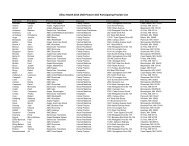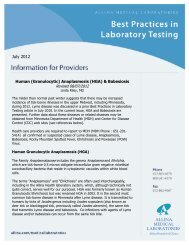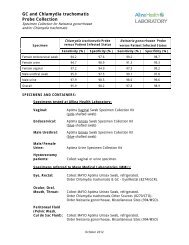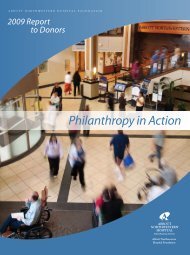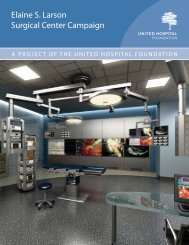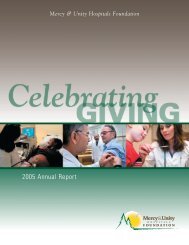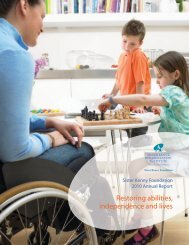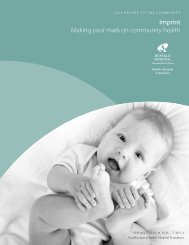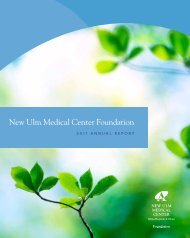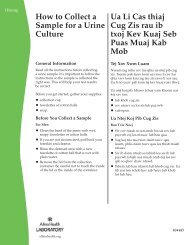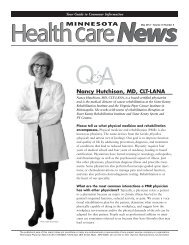Glossary - Allina Health
Glossary - Allina Health
Glossary - Allina Health
Create successful ePaper yourself
Turn your PDF publications into a flip-book with our unique Google optimized e-Paper software.
<strong>Glossary</strong><br />
Abstinence- refraining from sexual stimulation to the point of ejaculation.<br />
Acrosome- a compartment at the tip of the sperm head containing enzymes, which will<br />
breakdown the protective outer layer of the egg. The process of releasing these<br />
enzymes so the sperm can potentially fertilize the egg is called the acrosome reaction.<br />
Anti-sperm Antibodies- antibodies specific to a male’s sperm produced by the female or<br />
male partner. These antibodies can lead to destruction of the sperm and reduced<br />
fertility.<br />
Artificial Insemination- placement of sperm inside the female reproductive tract. A<br />
number of different techniques may be employed to increase pregnancy rates<br />
depending upon the needs of the patient.<br />
Artificial Insemination Donor (AID)- artificial insemination using donor sperm.<br />
Assisted Reproductive Technology (ART)- advanced procedures used to assist in<br />
achieving pregnancy. Includes procedures such a as IVF and GIFT.<br />
Azoospermia- the absence of sperm in the semen or failure of sperm production.<br />
Capacitation- a series of biochemical events that sperm undergo while traveling through<br />
the female reproductive tract. Sperm capacitation allows the sperm to acrosome react.<br />
Capacitation is necessary in order for a sperm to fertilize the egg.<br />
Cervix- the opening to the uterus from the vagina.<br />
Conception- the onset of pregnancy usually marked by the implantation of an embryo<br />
into the uterine lining.<br />
Cryopreservation- the process of preserving embryos, sperm or oocytes (eggs) by<br />
freezing.<br />
Donor Sperm- sperm from a man who is not a woman’s partner for the purpose of<br />
producing pregnancy.<br />
Ejaculation -a sudden discharging of a fluid, such as semen, from a duct.<br />
Fertilization- the combining of an egg and a sperm to create a new individual.
Gamete Intrafallopian Transfer (GIFT)- a method of assisted reproduction that involves<br />
removing an egg from the woman’s ovary, combining it with sperm, and injecting the<br />
egg and sperm into the fallopian tube. Fertilization takes place inside the fallopian tube.<br />
Hamster Egg Penetration Test (HEPT) - the most accurate test in predicting fertilizing<br />
ability of sperm. It can also predict the ability of laboratory techniques to improve sperm<br />
fertilizing ability. The sperm samples are evaluated for penetration capability. Also<br />
known as Sperm Penetration Assay (SPA).<br />
Hypo-osmolarity test (HOS)- a diagnostic test included in a semen analysis which yields<br />
information about the functional integrity of the sperm membrane. Used in conjunction<br />
with the sperm viability, sperm motility and sperm agglutination results, it can predict the<br />
possible clinical presence of anti-sperm antibodies.<br />
Implantation- the process of attachment of the embryo to the endometrial lining of the<br />
uterine wall.<br />
Infertility-the inability of a couple to achieve conception after one year of unprotected<br />
intercourse or the inability to carry direct pregnancy to live birth. More commonly known<br />
as subfertility.<br />
Insemination- the artificial introduction of semen into the genital tract of a female for the<br />
purpose of inducing conception; often referred to as intrauterine insemination (IUI) or<br />
intracervical insemination (ICI) depending on the placement of the semen in the female<br />
reproductive tract.<br />
Intracytoplasmic Sperm Injection (ICSI)- a technique by which a sperm is manually<br />
injected into the egg. This technique is used in conjunction with IVF.<br />
In Vitro Fertilization (IVF)- a method of assisted reproduction that involves removing<br />
eggs from a woman’s ovary, combining the egg with sperm in a dish and replacing the<br />
resulting embryos in the woman’s uterus.<br />
Lubricant- a substance, such as an oil or lotion, capable of reducing friction when<br />
introduced as a film between solid surfaces. The use of certain lubricants can be<br />
damaging to semen quality and so should not be used during semen collection.<br />
Luteinizing Hormone- a hormone produced by the pituitary, which acts upon the ovaries<br />
to prompt ovulation. About 36 hours before ovulation, the level of LH will greatly<br />
increase in the blood and subsequently the urine. This increase in LH is the "LH surge"<br />
and may be detected by testing the urine.<br />
Male Factor Infertility- infertility caused by semen or sperm abnormalities. This may<br />
include the production of insufficient numbers of sperm, insufficient sperm motility or<br />
sperm with abnormal morphological characteristics.
Masturbation- self-manipulation of the genitalia commonly resulting in orgasm which is<br />
achieved exclusive of intercourse or fellatio.<br />
Ovulation the discharge of a secondary oocyte (egg) from the ovary. Ovulation usually<br />
occurs approximately 14 days prior to the end of the reproductive cycle.<br />
Prostate Gland- a gland found at the base of the male urethra that secretes nutrients<br />
and buffers in an alkaline fluid and is a major constituent of the ejaculatory fluid.<br />
Semen -composition of sperm and seminal fluid released from the male urethra during<br />
ejaculation.<br />
Semen Analysis- the most economical method of evaluating male fertility. It is usually<br />
the first evaluation for the male investigating infertility with his partner. The major<br />
parameters of the semen analysis include the sperm concentration, progressively motile<br />
sperm count, and sperm morphology.<br />
Sperm Motility- the percentage of all moving sperm in a semen sample. Provides<br />
information on the ability of the sperm to reach the site of fertilization and may be<br />
indicative of fertility problems.<br />
Sperm Penetration Assay (SPA)- see Hamster Egg Penetration Test (HEPT).<br />
Sterile- free from living organisms and especially microorganisms. It is also a term given<br />
to a male who has no possibility of achieving fertilization via ejaculation.<br />
Testicles- male sex glands, which produce spermatozoa (mature sperm) and the male<br />
hormone testosterone.<br />
Uterus- a muscular organ in the female where the fertilized egg implants and the<br />
subsequent embryo and fetus develops. The lining of the uterus (endometrium)<br />
provides nutrients for the developing baby. The cavity opens through the cervix and into<br />
the vagina. The fallopian tubes extend from the top of the uterus and lead to the<br />
ovaries.<br />
Vagina- the female organ of sexual intercourse, where the sperm are deposited. It also<br />
serves as the birth canal.<br />
Vas Deferens- a thick-walled tube that begins at and is continuous with the tail of the<br />
epididymis within the testis and eventually joins the duct of the seminal vesicle to form<br />
the ejaculatory duct. They transport sperm from the epididymis to the urethra.




